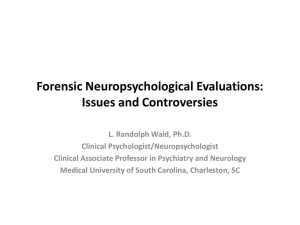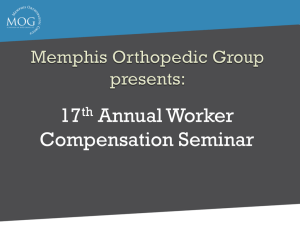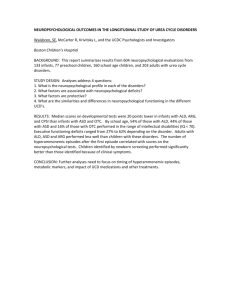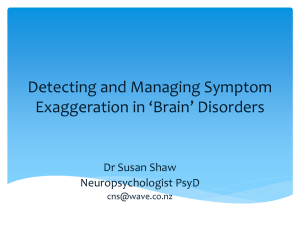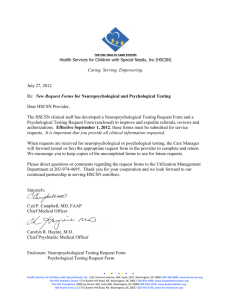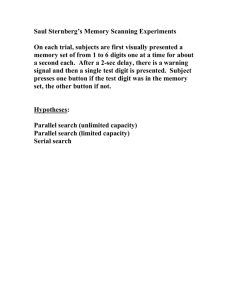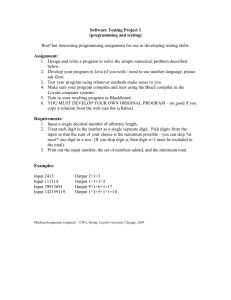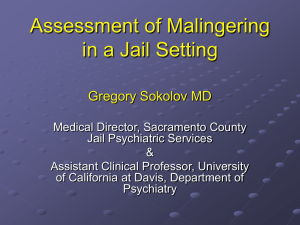Compensation for Mental Injury
advertisement
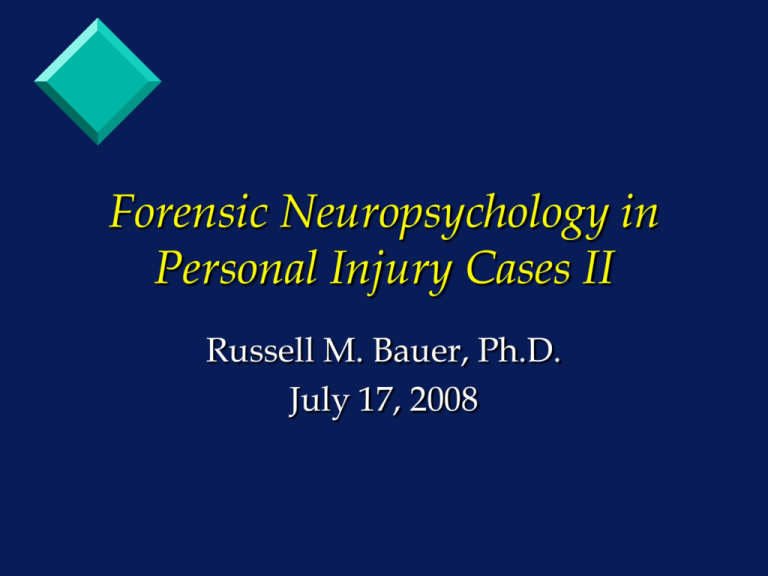
Forensic Neuropsychology in Personal Injury Cases II Russell M. Bauer, Ph.D. July 17, 2008 Assessment of Malingering and Poor Effort Issues with definition – Intentional (intention) – Fabrication or exaggeration (action) – For purposes of gain (motive) Explanatory models (Rogers, 1997) – Pathological (mental disorder) – Criminological (fake) – Adaptational (meeting adversarial demands) Cognitive vs. Somatic Malingering Diagnosis Threat (Suhr & Gunstad, 2002) 37 MHI (17 in “diagnosis threat” condition Diagnosis threat: told selected because of a MHI history; “a growing number of studies show that many individuals with head injury show cognitive deficits in neuropsychological tests” Suhr & Gunstad, 2002 * Suhr & Gunstad, 2002 Effort, Motivation, & Response Styles Frederick et al., 2000 Slick (1999) Considers evidence from NP and self report NP criteria – Definite or probable response bias – Discrepancies/inconsistencies between NP data and patterns of brain functioning, collateral reports, reports of past functioning Slick et al, 1999 (cont’d) DEFINITE MND Presence of financial incentive Definite negative response bias Behaviors that meet criteria for negative response bias that are not fully accounted for by psychiatric, neurological, or developmental factors PROBABLE MND Presence of financial incentive Two or more types of evidence from NP, excluding definite response bias, or one piece of evidence from NP and one from selfreport Malingering Research Literature Case study Simulation studies – Interpretive issues – Appropriate designs Differential prevalence design – contrasting high and low baserate groups (e.g., groups with and without financial incentives) – Valuable mostly for determining average performances Known-groups design – Selecting groups on the basis of malingering criteria (e.g., Slick, et al) – Examining differences between the groups Selecting Specialized Cognitive Effort Tests Ease of use Credibility of rationale Operating Characteristics – Incremental validity – TBI vs. PPCS Coaching issues There is not likely to be a “best” test in all circumstances Commonly Used Specialized Tests Portland Digit Recognition Digit Memory Test Computerized Assessment of Response Bias (CARB) Word Memory Test (WMT) Victoria Symptom Validity Test Test of Memory Malingering Validity Indicator Profile Rey 15-Item Test Dot Counting Test Detecting Anomalous Results with Embedded Measures and Performance Patterns Measures within standard NP tests that signify noncredible or ‘suspect’ performance Identification of such measures can be “rational” or “empirical” May be less subject to coaching than separate measures Pattern Analysis Pattern Analysis – With HRNB, DFA outperforms clinicians (80-90% v. 50-60%) – Most DFA’s multivariate , consisting of attention and memory measures Generally, measures malingers score better on hard – DFA’s exist for WMS-R, WMS-III, WAIS-R, WAIS-III and other tests – Before using, investigate whether the DFA was validated/cross validated with known groups or simulators Iverson & Binder, 2000; Larrabee, 2005 Embedded Measures – Motor, Sensory, and Perceptual-Motor Perceptual-motor pseudoabnormality should not be overlooked b/c of emphasis on “higher” cognitive disabilities Approaches – Neurologic exam – Sensorimotor impairments on NP exam Findings – RCFT copy 50% sensitive with lots of FP – Malingering groups favor memory over visuoconstructive impairment (e.g. memory trials of RCFT discriminate better) – Generally large grip strength effect size in NG designs – Reduced FT speed in the context of MHI Embedded Cognitive Measures – WMS-R/WMS-III Malingerers: Attention/Concentration < General Memory Opposite pattern to typical head injury Rarely-missed index on LM delayed recognition trials – WAIS-R/WAIS-III: Digit Span Malingerers: Low digit span performance (ACSS < 5) Reliable Digit Span (sum of longest correct span for both trials < 8) Vocabulary – Digit Span (low digit span while vocabulary is high) – CVLT Malingerers: Low recognition (hits & forced-choice) Cutoff scores for recall trials produce variable false-positive rates Variable results with most widely used cutoffs (Millis et al): Total < 35, LDCR <7, delayed recognition <11, discriminability < 81; sensitivity in question, not specificity Malingering Patterns in NΨ Tests Pattern Analysis – Word Memory Test Malingerers: Inconsistent responding, poor initial recognition Pattern should reflect severity of impairments – Category Test Malingerers: Poor performance on first 2 subtests – Wisconsin Card Sorting Task Malingerers: Poor ratios of categories completed compared to both perseverative errors and failure to maintain set Iverson & Binder, 2000; Larrabee, 2005 Why being a knowledgeable neuropsychologist is important You know likely patterns of impairment You know psychometric relationships among tests You know course of recovery You know about contributory factors (e.g., LD, depression, etc.) You can compare what you see to what you expect Common “suspect” neuropsychological signs on NP testing Recognition << recall (hits, discriminability) Extremely poor DS in the context of normal auditory comprehension (RDS) Motor slowing (e.g., reduced tapping) relative to overt motor disability Excessive failures-to-maintain-set on WCST Discrepancies between test level and level during informal interaction Other “impossible” signs Some Take Home Messages Use multiple measures (forced choice, embedded, etc.) Clarify your goals: sensitivity, specificity, etc. Be aware of correlations among malingering measures Look for emerging research on sensitivity/specificity of multiple indicators Symptom Exaggeration Self-Report of Symptoms – May be exaggerated due to other variables (depression, pain, stress) e.g., Post-Concussive Syndrome persisting for more than 3 months MMPI-2 – Malingerers tend to show elevations in clinical scales 1, 2, 3, 7, and 8, the Fake Bad Scale (FBS), VRIN, TRIN, the InfrequencyPsychopathology Scale [F(p)]. – The F Scale and F – K does not appear to be as sensitive, and therefore “valid” profiles may be obtained. – Caution should be given to interpreting the clinical scales and F Scale derivatives, as these can be easily influenced by psychiatric comorbidities. Iverson & Binder, 2000; Larrabee, 2005 Detecting Somatic Malingering Symptom report, as well as cognitive performance, can be controlled by the litigant Use of MMPI-2 – – – – – F-scale, F(p) VRIN, TRIN Subtle-Obvious F-K index Revised Dissimulation Scales These scales may not be sufficiently sensitive to TBI-related claims, despite neuropsychological differences Lees-Haley FBS Model of goal-directed behavior: – Want to appear honest – Want to appear psychologically normal except for the influence of injury – Avoid admitting longstanding problems – Minimize pre-existing complaints – Minimizing pre-injury antisocial or illegal behavior – Presenting plausible injury severity Lees-Haley FBS (cont’d) 18 “True” , 25 “False” Does not correlate very strongly with Fscale derivatives Most scale items overlap with “neurotic” side of MMPI Cut-off mid 20’s, with varying false positive rates; increasing security with scores > 25-27 FBS Operating Characteristics Most frequently failed indicator of MND (Larrabee) FBS > 27 has Sn=.46 , Sp=.96, better than F or Fb (Greve et al) Sensitive to symptom exaggeration in personal injury, not just litigation Cutoffs determine TP, FP rate Critical Studies Butcher et al (2003) – Unacceptably high FP of FBS (24% of males, 37.9% of females exceeded cutoffs) – Psychiatric, corrections, medical, pain, VA, personal injury litigants – No measures of symptom validity external to the MMPI – No report of who was litigating – Can’t compute specificity or sensitivity without this information Bury & Bagby (2002) – – – – – PTSD vs. students (standard and exaggeration instructions) F family produced best overall classification rates Entire PTSD sample were being evaluated for workplace disability Mean PTSD FBS was 26.31 No independent measures of malingering or exaggeration Neuropsychology for Physicists: “Neuropsychological testing was highly consistent with her 2/8/97 automobile accident. That is, she showed evidence suggestive of significant shearing damage, the frontal system being damaged bilaterally, with relative sparing of the intentional memory system structures and posterior brain areas, a pattern expected with an injury in which the brain is spun and then violently counterspun within the skull. She also showed significant deficits with passive attention plus more problems with incidental than intentional memory. This suggests reticular activating system damage such as would occur with significant shearing and/or when the brain is slammed down against the tentorium. Hypothalamic symptoms were numerous. Damage to this nucleus is quite common in this type of injury as well. Finally, Ms. X showed some right posterior deficits, but sparing of left posterior function. This suggests a possible right posterior/left frontal coup/contracoup pattern overlaying the bilateral frontal system shearing. This dual pattern can occur in an accident such as hers where the driver is seat-belt restrained and the left front of her car is hit. Ms. X reported symptoms consistent with mild to moderate depression. The pattern of her neuropsychological deficits was inconsistent with scores of non-head-injured patients suffering from depression. The pattern of Ms. X’s neuropsychological damage and residual strengths, the nature of her 2/8/97 MVA, and the timing of symptom onset all indicate the cause of her present brain damage to be the 2/8/97 accident. Patient after MVA, with no LOC, undergoes neuropsychological testing, has a normal neuropsychological evaluation. He has a VIQ of 106 and a PIQ of 89. On WMS, he has an MQ of 108, but only remembers an average of 6 items on Logical Memory. Other verbal memory tests are normal. The patient is mildly depressed and faces several orthopedic surgeries for lower extremity injuries. The neuropsych is summarized: “Based on the present test results there is evidence that Mr. X is experiencing significant cortical dysfunctioning. His organic deficits appear to be highly lateralized and focal in nature. Specifically, he is manifesting significantly impaired visual motor skills relative to verbal skills. This finding is consistent with Organic Brain Dysfunction and in particular consistent with Nondominant Hemisphere Dysfunction. In addition, when one compares Mr. X’s premorbid level of intellectual functioning to his present level of intellectual functioning it is clear that his overall intelligence has declined (no records obtained by him, attentional problems/poor school attendance later discovered from records I obtained). In addition, test results indicate localized organic impairment for both short term verbal memory functioning as well as delayed verbal memory functioning. This finding is highly consistent with dominant temporal cortex lesioning. With regard to psychological functioning, there is evidence of clinically significant levels of depression (MMPI 2-scale at 68, no other scales elevated, patient reports loss of interest and mild dysphoria). It is strongly believed that the patient’s organic dysfunctioning and depression are directly related to the automobile accident on February 8, 1997.”
